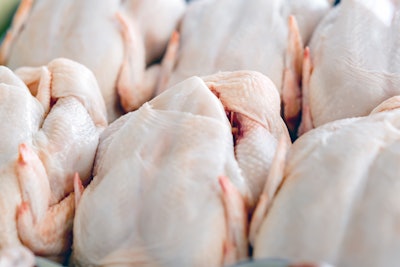
Global poultry meat trade is projected to be 16.8% higher in 2030 than in the base period 2018-20, with a total quantity projected at 17.5 million metric tons in 2030, according to the Food and Agriculture Organization (FAO). In 2030, global poultry meat exports are projected to amount to 44% of total world meat exports, followed in second place by beef at 28%. Global poultry meat exports were almost 12 million metric tons in 2021, according to a report from the U.S. Department of Agriculture (USDA) (Figure 1).
Nevertheless, meat trade remains important in securing global food supply and nutritional resources for both importing and exporting countries. In addition to Organization for Economic Cooperation and Development (OECD) countries, developing countries will play a role in this over the next decade, with Vietnam in particular expected to import more poultry. The increased trade in Asia and other developing countries will boost the value of overall poultry meat trade from US$16.9 billion in 2020 to US$19.6 billion over the next decade to 2030 (Figure 2)
Export, import specifics
Exports of poultry meat from developing countries are projected by developing countries to grow from an average of 7,469 thousand metric tons over 2018-20 to 9,071 thousand metric tons by 2030, outpacing the growth of OECD (developed) member countries (Figure 3). Developing countries will still largely account for most imports over the next decade as well. Imports in developing countries will reach 11,223 thousand metric tons by 2030 compared with just 4,570 thousand metric tons for OECD countries in 2030, according to projects from OECD (Figure 4).
Asia is projected to be the world’s leading poultry meat importing region in 2030, with 7.3 million metric tons of imports, up from an average of 6.3 million metric tons in the base period 2018-20 (Figure 5). In terms of exports, Latin America again holds the title of highest exporter with 4.6 million metric tons averaged from 2018-20 and 5.8 million metric tons in 2030 (Figure 5). North America will remain the second largest poultry exporting region in 2030, exporting an estimated 4.2 million metric tons.
Country specifics
In the U.S., poultry meat trade will remain relatively flat in the short term (Table 1). This continues to be due to uncertainty around COVID and vaccine mandates impacting the supply chain and workforce, among other things. In 2021, the U.S. is projected to import 136 million pounds of broilers and export 7,450 million pounds. As far as turkey meat, the U.S. is projected to import 21 million pounds in 2021 and export 580 million pounds (Table 1)
The EU demand for poultry meat and eggs is projected to grow steadily as consumers see it as a healthy and sustainable product. Poultry production is expected to be the only meat category to grow. EU egg trade has grown slightly in imports and exports between 2018 and 2020 (Figure 6).
Download more poultry market data
EU-27 egg trade balance 2017-21
Meat trade quantity and value by type 2010-30
Global poultry meat trade trends 2017-21
Poultry meat trade by region avg. 2018-20 vs 2030
Poultry meat trade quantity and value forecast
US poultry meat trade by type 2019-21
World poultry meat export projections to 2030
World poultry meat import projections to 2030

















